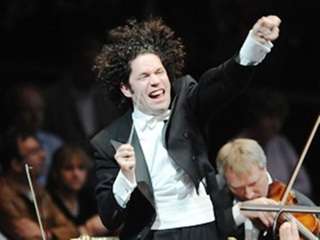|
Back
A Pair of Ornery Symphonists New York
Isaac Stern Auditorium Carnegie Hall
02/25/2018 - & February 17, 18 (Vienna), March 2 (México), 2018
Charles Ives: Symphony No. 2
Pyotr Ilyich Tchaikovsky: Symphony No. 4 in F Minor, Opus 36
Vienna Philharmonic Orchestra, Gustavo Dudamel (Conductor)

G. Dudamel (© Chris Christodoulou)
Everything had been wrong–historically–after listening to this dynamic pulsing, extravagantly gripping performance of the Vienna Philharmonic Orchestra this afternoon.
Charles Ives had been wrong when he put Tchaikovsky in the list of “sissifieed” bloodless European composers. The way Gustavo Dudamel conducted the Fourth Symphony, the Russian, with his marches and folk songs, should have been idolized by the Yankee insurance executive/cum composer.
America was wrong when they refused to play Ives’ Second Symphony for more than half a century after its composition. After Dudamel’s singular interpretation, Ives seemed less avant-garde than Edward MacDowell, and a helluva lot more conservative than Gustav Mahler, who was working on his last symphonies in New York just a few miles from Connecticut-based Charles Ives.
History, however, was corrected by the Venezuelan wunderkind with his Viennese orchestra with both the (personally) misunderstood Russian and the (musically) misunderstood Yankee.
And those of us who saw Mr. Dudamel control his unlikely forces won’t soon forget it.
Of course we all expected a terrific Tchaikovsky. But what would result from those Mitteleuropea virtuosi, raised on the composers who Ives had ostracized from his personal codex?
That was the irony. In his piano sonatas, his quartets and songs, Ives was the outlier. In this Symphony, Gustavo Dudamel conducted a sweet–yes, sweet–academically counterpointed, conservatively harmonic, late 19th Century piece of music.
Oh, yes, the American tunes came through like brusque cantus firmi from the Vienna Phil brass. And that last catastrophic chord was great joke. Though harmonically no more a surprise than the last chord of Mozart’s own Musical Joke.
So if one looked at this as a heavy, sometimes smothering piece of music, nothing was wrong with that. The orchestration was sometimes Schumannesque-murky. But Ives had done his musical exercises with the best teachers, and had studied band music with his father, and the results were frequently gorgeous.
That first movement has its obvious emotional allusions to Columbia, The Gem of the Ocean. (Did Ives know that the tune came from an equally patriotic song by those sissy Englishmen?). But Maestro Dudamel gave it a different look. We had a mysterious opening, an amorphous introduction. The conductor did the near impossible, bringing it to a slow extended crescendo, so subtle that one could hardly hear it.
His control over the Vienna Phil was total. Yes, orchestra had its technical faults (a few blurts and bleeps from the brass in the Tchaikovsky wouldn’t have been tolerated with the NY Phil.) But the Vienna Phil strings are unparalleled, and Ives relished those sounds. These were not the sounds of the village band, but those of a great orchestra. And methinks even Ives might have appreciated their greatness.
The slow movement was, yes, supposed to be a takeoff on church music of the time, but here one felt more the depth of Europe than the reedy organs of the Congregationalist church. As for the finale, this was pure Ives. Not the transcendental Ives or even the iconoclastic Ives. Just a rollicking good-natured composer having fun with lots of familiar songs.
Dvorák’s American music quoted from African-American and Indian music, but the closest Ives ever came to “exotica” were the ersatz-Negro Stephen Foster songs. Camptown Races, Ol’ Black Joe and of course Columbia. The Vienna Phil got up to the spirit of the thing with a series of big thumping bass-drum blows, and the brass–more accustomed to Mahler–played the reveille while the orchestra crumbled to happy pieces for the final...er...chord.
Leonard Bernstein, with Stokowski, championed Ives, and Dudamel’s performance was a bit heavier. But Ives was a rascally old writer, and he might have reveled in the action.
After the intermission came a work written just a few years before the Ives. But not that different. Again, we had a composer dousing himself with native folk tunes, with marches, with orchestral tricks (that all-pizzicato scherzo) and with a dynamic ending.
All of which was offered with Dudamel’s enthusiasm and control.
It was not totally spirit, though. The conductor slowed down to the cusp of schmaltz during the waltz, only to lift the orchestra up again to the movement finale. The pizzicato strings showed the Phil at its best, and for the finale, the brass made up for their earlier errors with a full-blooded climax.
Unlike Ives, who hid his Americana into hints and secret passages, Tchaikovsky used his “Birch-Tree” peasant song as the main theme, and let it all hang out. Allowing Dudamel to do the same.
The performance of both works was exhilarating and one dreaded an encore which might put a pall on the concert. Not to worry. Dudamel played the Swan Lake waltz with Gustavo-gusto, ending a concert offering (as Ives orchestrated in another symphony) both comfort and joy.
Harry Rolnick
|